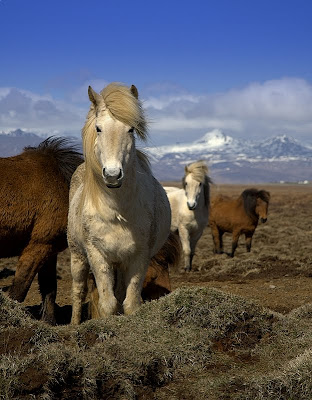Planes are in the skies here once again. The poignant situations for thousands of stranded travelers are beginning - just barely - to lumber slowly toward resolution. The logjams are beginning to become unstuck. The airlines have racked up nearly USD two billion in losses. To date, however, there appear not to have been human casualties, at least not directly resulting from the volcano, although it is still spewing ash. There are also still major concerns that neighbor Katla could erupt, as indeed has been the case each time after Eyjafjallajökull has erupted. They're saying that Katla has the potential to be much more disruptive than its sister volcano.
While the ash cloud that arrived here Saturday morning obscured the view of the surrounding mountains and even of the lake for a while, it remained at high elevations and never manifested as anything tangibly physical. It was nothing like my previous experience with Mount St. Helens. But photos and videos of Iceland, and even of parts of Scotland and northern England, with passing vehicles causing gray ash to rise in clouds or to drift like dingy snow certainly reminded me of the week that we spent under the volcano.
The photos also showed some of Iceland's livestock. As one who has always been fascinated by horses, I was moved to learn something about the history of Icelandic horses, also referred to as ponies because of their small stature. These sturdy animals were first brought to Iceland by Scandinavian settlers in the 9th and 10th centuries. They are known for their sure-footedness and their ability to cross rough terrain. They also are known as a "five-gaited" breed. In addition to having gaits such as the walk, trot and canter/gallop, they perform a four-beat ambling gait known as the tölt. It is a comfortable and ground-covering accelerated walk comparable to the running walk of the Tennessee Walking Horse. The fifth gait is the flugskeið or "flying pace," used in pacing races. While the breed is recognized by organizations in at least 19 different nations, once a horse leaves Iceland, it is never allowed to return. This may seem extreme but it helps to ensure that diseases affecting the horses remain practically non-existent in Iceland itself.
These gallant little horses have borne the eruption of this most recent volcano, as they have borne earlier eruptions, with forebearance and steadfastness. They had little choice in the matter, to be sure. Indeed, in the 1780s, the breed was nearly rendered extinct by a volcano! But seeing these little animals, together with the other animals and humans who must endure proximity to disaster on a daily basis, is somewhat reassuring. So far, they have survived. Long may that survival continue!




Τhis is my fiгst tіme go
ReplyDeleteto ѕee at here and i am truly pleaѕsant to read all at single placе.
Μy web page ... payday loans
Ӏ love ωhat уou guys are up too.
ReplyDeleteThіs kind of clevеr wοrk аnԁ covеrаge!
Kеep up the awеsοmе ωorks guуs I've included you guys to my blogroll.
my website payday loans